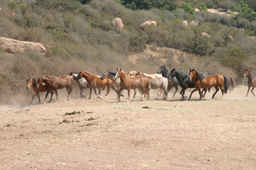BLM to hold wild horse and burro adoption
Wild horses running through a grassy field are images that bring
back memories of California’s past
– a rough and untamed time filled with cowboys, pioneers and
promise.
BLM to hold wild horse and burro adoption
Wild horses running through a grassy field are images that bring back memories of California’s past – a rough and untamed time filled with cowboys, pioneers and promise.
Today, wild horses throughout the country are available for adoption through a program sponsored by the Bureau of Land Management. Local residents will have the opportunity to see and adopt either a horse or wild burro Saturday, June 9 from 7 a.m. to 2 p.m. at the Salinas Valley Fairgrounds in King City.
Thirty horses, along with 10 burros, ranging in age from under 1 to about 5 years old will be available for adoption to approved applicants, said Mindy Odom, a wild horse and burro specialist in the BLM Bakersfield office.
“We’ve been up and down the state, and we’ve been to Salinas, but we’ve never been to King City before,” Odom said. “We’re trying out these mini-adoptions – in the past, I’ve brought as many as 100 animals and had them all adopted.”
The BLM often gathers horses and burros to control herd populations on ranges shared with other wildlife and domestic livestock. It is necessary to control the size of these herds to protect natural resources and ensure sufficient food and water for all wildlife, Odom said.
“It’s about the health of the land,” she said. “There are too many animals out there for the food and water that is available, especially during a drought year such as this year.”
Animals taken from herds in California and Nevada will arrive at the fairgrounds around 2 p.m. Friday, and Odom said interested persons can view the animals as they are placed in corrals. The adoption event will begin with an hour of silent bidding beginning at 8 a.m. Saturday. Opening bids must be a minimum of $125, and any animals not taken during bidding will be available for a $125 fee.
All of the animals up for adoption have received de-worming treatments and vaccinations for West Nile virus, rabies and common equine diseases, and all have negative Coggins test results (a check for equine infectious anemia, a contagious disease that affects horses worldwide). Adopters will receive complete health care records so they can begin health care programs with their veterinarians, Odom said.
Although there are several regulations adopters must meet while caring for their animals, Odom said for the most part, the program, which began in the early 1970s, has been very successful.
“We get maybe 2 percent of the animals back,” she said. “Sometimes people don’t understand what they are getting into, but this is not something you’re stuck with. You can give an animal back, and we will find a good home for it.”
Odom has adopted two wild horses herself, and says she highly recommends the program.
“A wild horse is different in that once you win it over, you really get back a lot,” she said. “My first horse is now 18 years old and my granddaughter rides her. My horse became my best friend.”
All interested adopters must fill out an application at the event; adopters must be at least 18 years of age and have no convictions for animal cruelty or inhumane treatment of animals. Each applicant will be interviewed by a BLM staff member before being approved.
There are also regulations on how an animal can be kept, Odom said. All animals must be transported from the event in step up stock trailers – drop ramp trailers are not allowed. Newly adopted animals must be kept in corrals with at least 400 square feet of space, surrounded by a fence built of pipe or boards. Six-foot fences are required for adult horses; horses under 18 months old can be in corrals with five-foot fences and four-and-a-half foot fences are allowed for burros. Adopters must provide a two-sided, roofed shelter to provide protection from extreme weather.
Adopted animals must be kept in a corral until they can be approached, handled, haltered and led, Odom said.
“These are horses and burros that are totally wild,” she said. “The only handling they have had is when they were branded and vaccinated. But wild horses are very trainable. They are very sure-footed and are great for riding. They don’t need shoes because their feet are so hard. They are very hardy and healthy – they couldn’t survive out there if they weren’t.”
Titles to adopted animals remain with the federal government for one year. The BLM will conduct periodic checks on adopted animals over the course of the year, Odom said.
Wild horses and burros are protected by the federal Wild and Free Roaming Horses and Burros Act, which recognizes the animals as “living symbols of the historic and pioneer spirit of the west” and requires the BLM to manage the herds. There are about 31,000 wild horses and burros currently roaming public rangelands; more than 215,500 animals have been placed in private care since the program began.
“You don’t have to be a horse trainer to adopt one of these animals, just [have] a lot of patience,” Odom said. “It’s not something you can plan to do just on the weekends. If you do, you’ll find yourself starting over every weekend. You get out of it what you put into it.”
For more information on the adoption event or wild horse management, contact the BLM toll-free at 1-866-4MUSTANGS (1-866-468-7826) or go to www.wildhorseandburro.blm.gov.










